
Mount Foraker is a 17,400-foot (5,304 m) mountain in the central Alaska Range, in Denali National Park, 14 mi (23 km) southwest of Denali. It is the second highest peak in the Alaska Range, and the third highest peak in the United States. It rises almost directly above the standard base camp for Denali, on a fork of the Kahiltna Glacier also near Mount Hunter in the Alaska Range.

Mount Russell is one of the major peaks of the central Alaska Range, approximately 35 mi (56 km) southwest of Denali. Though much lower than Denali or its neighbor Mount Foraker, Russell is a steep, dramatic peak and a significant mountaineering challenge in its own right. To give a sense of its size and steepness, note that its summit rises 6,560 ft (2,000 m) over the Chedotlothna Glacier to the northwest in only 1.8 mi (2.9 km), and almost 10,000 ft (3,000 m) above the lower Yentna Glacier to the south in only 8 mi (13 km).

Mount Church is a 7,621-foot (2,323 m) mountain in the Alaska Range, in Denali National Park and Preserve, overlooking Ruth Glacier. It is situated on the west side of the Ruth Gorge and 0.87 mi (1 km) southeast of Mount Grosvenor, which is the nearest higher neighbor. The mountain was named by famed explorer Dr. Frederick Cook who claimed the first ascent of Mount McKinley in 1906, but was later disproved.
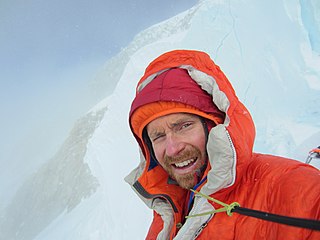
Colin Haley is an American alpinist known for fast ascents of technical routes on mountains around the world. Haley is perhaps best known for his traverse of The Torres, first with Rolando Garibotti in 2008, and subsequently with Alex Honnold - this time completing the traverse in under 24 hours.

Mount Johnson is an 8,400+ ft mountain summit located in the Alaska Range, in Denali National Park and Preserve, in Alaska, United States. It is situated on the west side of the Ruth Gorge, 15 miles (24 km) southeast of Denali and six miles (9.7 km) south-southwest of The Moose's Tooth. The nearest higher neighbor is Mount Wake, 0.69 miles (1.11 km) to the northwest.
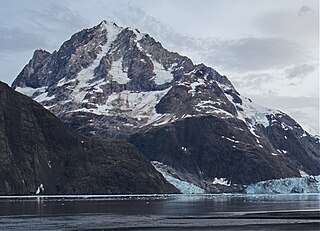
Mount Abbe is an 8200+ feet double summit mountain located in the Fairweather Range of the Saint Elias Mountains, in southeast Alaska. The peak is situated near the terminus of the Johns Hopkins Glacier, within Glacier Bay National Park and Preserve, 100 mi (161 km) northwest of Juneau, and 8.2 mi (13 km) northeast of Mount Orville. Although modest in elevation, relief is significant since the mountain rises up from tidewater in less than two miles. Mount Abbe is often seen and photographed with the Johns Hopkins Glacier, which is a popular destination for cruise ships. The mountain was named in 1936 by William Osgood Field and William Skinner Cooper, of the American Geographical Society, for Cleveland Abbe Jr., (1872-1934), an American geographer. Abbe received a Ph.D. in 1898 from Johns Hopkins University. The Gilman Glacier and Clark Glacier on the mountain's slopes were named for Daniel Coit Gilman, the institution's first president, and William Bullock Clark who was a professor of geology at the university. The mountain's name was officially adopted in 1937 by the United States Geological Survey. The first ascent of the south summit was made June 11, 1977, by Jim Wickwire and Dusan Jagersky via the Southeast Face. Three days later, Dusan Jagersky was killed while descending an unnamed peak. The first ascent of the north summit was made July 14, 1991, by Walter Gove and William Pilling. The months May through June offer the most favorable weather for climbing Mount Abbe, but it's a challenging climb in any conditions, with few attempts.

Mount Bertha is a 10,204-foot (3,110-meter) glaciated mountain summit located in the Fairweather Range of the Saint Elias Mountains, in southeast Alaska, United States.

Mount Huxley is a 12,216-foot glaciated mountain summit located in the Saint Elias Mountains of Wrangell-St. Elias National Park and Preserve, in the U.S. state of Alaska. The remote peak is situated 75 mi (121 km) northwest of Yakutat, and 8.7 mi (14 km) west-northwest of Mount Saint Elias. The peak rises above the Columbus Glacier and Bagley Icefield to its north, the Tyndall Glacier to the south, and the Yahtse Glacier to the west. Precipitation runoff from the mountain drains into the Gulf of Alaska. The mountain was named in 1886 by English mountaineer Harold Ward Topham for Thomas Henry Huxley (1825-1895), an English biologist. The mountain was officially named Huxley Peak in 1917, but the name was officially changed to Mount Huxley in 1968 by the U.S. Board on Geographic Names. The first ascent of the peak was made June 9, 1996 by Paul Claus who landed his plane at 11,500 feet elevation on the western flank and climbed the remaining distance to the summit. The second ascent of Mt. Huxley, and first complete ascent from base to summit, was made in June 2018 by Scott Peters, Andrew Peter, and Ben Iwrey starting from the Columbus Glacier.
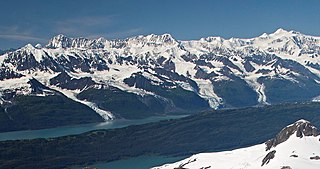
Mount Grace is a remote 10,540-foot (3,213 m) glaciated mountain summit located in the Chugach Mountains, in the U.S. state of Alaska. The unofficially named peak is situated 63 mi (101 km) east of Anchorage, 6 mi (10 km) north of College Fjord, 3.35 mi (5 km) east of Mount Goode, and 9.37 mi (15 km) southwest of Mount Marcus Baker, on land managed by Chugach National Forest.

Mount Grosvenor is an 8,400+ ft mountain summit located in the Alaska Range, in Denali National Park and Preserve, in Alaska, United States. It is situated on the west side of the Ruth Gorge, 0.87 mi (1 km) northwest of Mount Church and 0.54 mi (1 km) south of Mt. Johnson. Its nearest higher peak is Mount Wake, 1.32 miles (2.12 km) to the northwest. Despite its relatively low elevation, it is notable for its east face with over 4,000 feet of vertical sheer granite. The mountain was named by famed explorer Dr. Frederick Cook who claimed the first ascent of Denali in 1906, but was later disproved. This peak's unofficial name honors Gilbert Hovey Grosvenor (1875–1966), President of the National Geographic Society, father of photojournalism, and the first full-time editor of National Geographic magazine. The first ascent of the peak was made in 1979 by Gary Bocarde, Charlie Head, John Lee, and Jon Thomas.
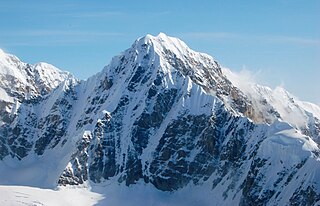
Kahiltna Queen is a 12,380-foot-elevation (3,773-meter) mountain summit in the U.S. state of Alaska.
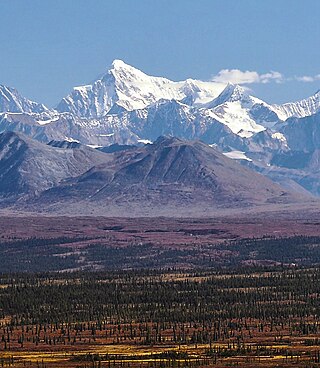
Mount Balchen is an 11,205-foot-elevation (3,415-meter) mountain summit in Alaska, United States.

Mount Emmerich is a 6,877-foot-elevation (2,096-meter) mountain summit in Alaska.
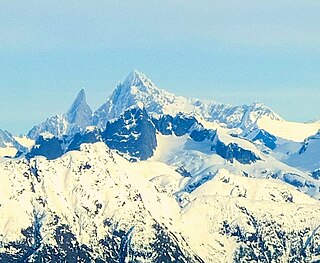
Mount Burkett is a 9,730-foot-elevation (2,966-meter) mountain summit in Alaska, United States.

Royal Tower is an 8,130-foot-elevation (2,478-meter) mountain summit in Alaska.

Mount Gerdine is an 11,258-foot-elevation (3,431-meter) mountain summit in Alaska.

Mount Chichantna is a 10,893-foot-elevation (3,320-meter) mountain summit in Alaska.

Fifty Years of Alaskan Statehood is an 8,599-foot (2,621 m) mountain summit in the US state of Alaska.

Mount Skarland is a 10,375-foot-elevation (3,162-meter) mountain summit in Alaska, United States.

Mount Geist is a 10,716-foot-elevation (3,266-meter) mountain summit in Alaska, United States.























